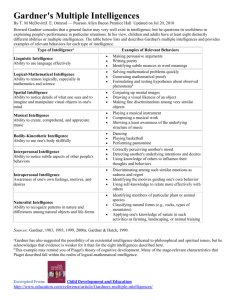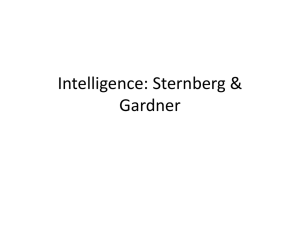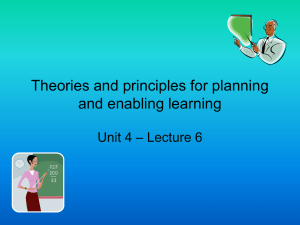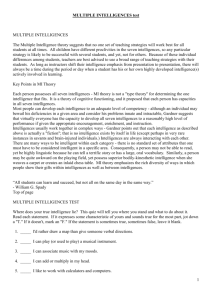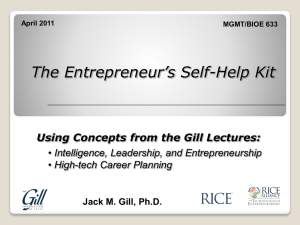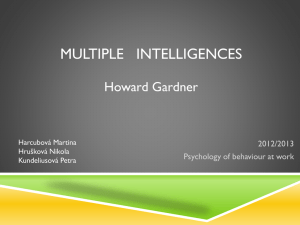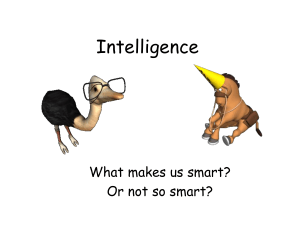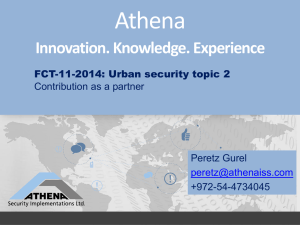Research Proposal
advertisement
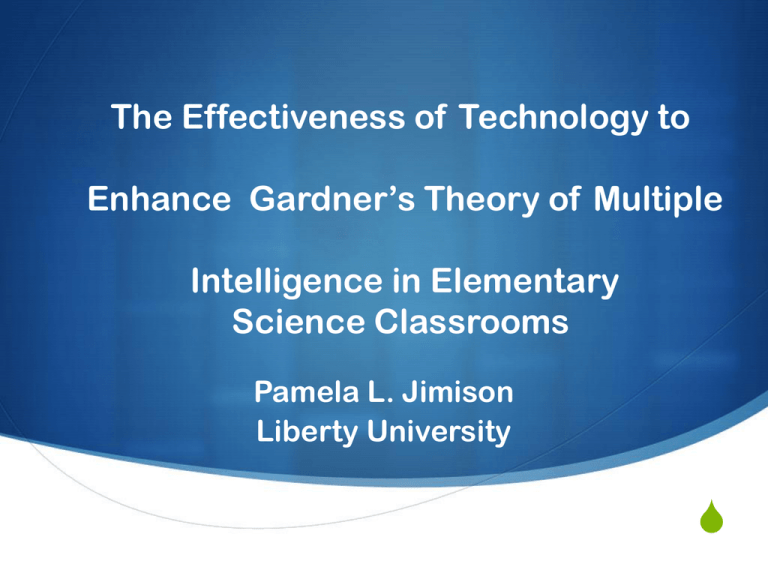
The Effectiveness of Technology to Enhance Gardner’s Theory of Multiple Intelligence in Elementary Science Classrooms Pamela L. Jimison Liberty University S Abstract Teachers must try to differentiate instruction to meet the needs of a student’s intelligence. Technology is one tool to use for differentiation. Purpose… …to determine the effectiveness of technology to enhance Gardner’s theory of multiple intelligences in the elementary science classroom. S Question & Hypothesis S Research Question: S Does technology-enhanced multiple intelligence differentiated instruction improve student achievement in the elementary science classroom? S My Hypothesis: S Students in the experimental classroom (technology) will have higher scores in the final assessment than those in the control group. What is MIT? Psalm 139: You are wonderfully made! (McCoog, 2007) What is knowledge? According to Adams (2004) knowledge can be defined as what we know or believe to exist. The ways of knowing are how we internalize knowledge (Adams, 2004). and I have filled him with the Spirit of God, with wisdom, with understanding, with knowledge and with all kinds of skills—Exodus 31:3 What is intelligence? Intelligence is the ability to solve problems, or fashion products, that are valued in one or more cultural or community settings. (Gardner, 1983) Dependent Variable? Student test scores! (What do I observe?) Controlled Variable? Pretest and post-test Independent Variable? Type of instruction ~ teacher or technology? Students with technology-enhanced instruction will score higher on the posttest than those in a traditional classroom. Literature Review - Summary Programming, chemistry, design Multimedia, 3-D, graphics Typing, keyboard, mouse Podcasts, music, multimedia Photos, exploration Blogs, wikis, groups Social networking Compose, blogs, wikis (Gooch, 2011) S Students started Literature Review Grandfather Academy out as selfdefeated and angry. The school utilized servant leadership and technology. S Students became proud, selfdirected learners. (Herman, 2008) S Inclusion school for MIT Literature Review Hemenway School Boston, Massachusetts S Students modified artists’ pictures in paint, wrote poems, created multimedia projects S Students far exceeded the mastery of content required. (Lach, Little, & Nazzaro, 2003) S Quantitative and Literature Review 2 Turkish Studies qualitative study on use of blogs. It revealed that technology was engaging and interactive. (Kalelioglu, 2010) S Quantitative study on MIT in computer classes ~ students scored high with technology than traditional classroom teaching. (Ozdener, 2004) Significant Themes from Literature Reviews: Technology is one tool that can tap into the varying intelligences and allow the educator to better meet the needs of students. In the elementary science classroom, technology can be used to enhance the learning community and engage learners. It allows the teacher to supplement strengths and improve weaknesses. My Research Design Proposal Experimental Research Using Quantitative Methods S Students grades 4-6 S Randomly assigned to experimental or control group S Science class Sampling S Time period: one semester Methods of data collection Administer Multiple Intelligence Fields Observation Form Student Version to determine predominant intelligences Administer a 75 question pretest to both groups Observation Notes Administer the same 75 question post-test to both groups Data Analysis Procedures S The groups pretest averages will be compared using a t-test to determine significant difference S Use statistical analysis Mann Whitney U Test S P>.05 Data Analysis Procedures S The groups post-test averages will be compared using a t-test to determine significant difference S Use statistical analysis Mann Whitney U Test S P>.05 S Compare the post-test results for a meaningful difference Ethics and Human Relations Teachers shall apply for the study and give their consent. http://www.aglbical.org/ethics1.jpg Students and parents will sign informed consent. There will be no bias for race, gender, or religion. The teacher shall make sure there is no harm or discomfort to students in the study. Ethics and Human Relations S Research agenda will http://popularconduct.com/wpcontent/uploads/2010/06/ethicssign.jpg be disclosed to involved school administration, teachers, and parents of students in the study. S The researcher shall exhibit integrity. Proposed Timeline March - April April - May June July-August September September - Jan February March - finish Create web site, online application form Teachers apply, assess applications, visit schools Consent forms to administration / teachers Parent consent forms, teacher meetings MIT Test, pretest, analysis Student classes, observations Post-test, analysis Analysis, reports, web site, thank participants References Adams, N. B. (2004). Digital intelligence fostered by technology. Journal Of Technology Studies, 30(2), 93-97. Gall, J., Gall, M., & Borg, W. (2010). Experimental Research. In Applying Educational Research. (6th ed.). (pp. 292-317). United States of America: Pearson. Gooch, K., & Saine, P.. (2011). Integration of the visual arts and web 2.0 technologies in the classroom. New England Reading Association Journal, 47(1), 92-101. Retrieved November 6, 2011, from ProQuest Education Journals. (Document ID: 2478462011). Halasa, K. (2005, May 11). Annotated Bibliography: Ethics in Research. AARE. Retrieved December 9, 2011, from http://www.aare.edu.au/ethics/aareethc.htm References Iflazoglu Saban, A. (2011). An evaluation of the teaching activities implemented in the elementary science and technology courses in terms of multiple intelligence theory: A sample from Adana. Educational Sciences: Theory And Practice, 11(3), 1641-1649. Jackson, A., Gaudet, L., McDaniel, L., & Brammer, D. (2009). Curriculum integration: The use of technology to support learning. Journal Of College Teaching & Learning, 6(7), 71-78. Kalelioglu F, Gulbahar Y. Investigating the usage of blogs in educational settings from multiple intelligences perspective. Turkish Online Journal Of Educational Technology [serial online]. April 2010;9(2):132-144. Available from: Education Research Complete, Ipswich, MA. Accessed November 6, 2011. Özdener, N., & Özçoban, T. (2004). A project based learning model's effectiveness on computer courses and multiple intelligence theory. Educational Sciences: Theory & Practice, 4(1), 176-180.

